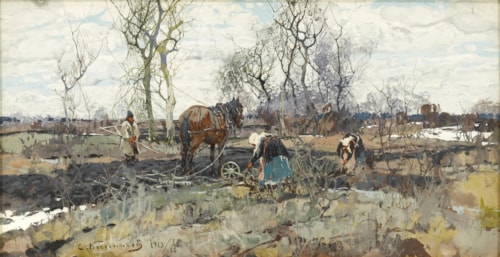illiam McConnell
(British fl.1850 - 1890)
An Officer in a Horse-Drawn Carriage, St. Petersburg
inscribed and dated ‘Petersburg/2 April 1875’ (lower left);
further inscribed and dated ‘22 april 1875/ St. Petersburg’ (lower right)
pencil, pen and black ink and watercolour on paper, heightened with white
12.6 x 21 cm (5 x 8¼ in)
With his head down, a stern looking officer tucks his hands firmly under his cape, as the plume of his helmet flickers in the wind. The officer’s helmet is a pickelhaube. Originally designed by King Frederick William IV of Prussia (1795-1861) in 1842, and simultaneously adopted by the Russian army, the pickelhaube was made from hardened leather. The helmet was finished with black lacquer, decorated with metal trim, and topped by a metal spike. The original Russian version had a small ball from which the spike emerged, and to the end of this was attached a plume of horsehair. After 1862, the pickelhaube ceased to be worn by the Russian Army, although it was retained until 1914 by the Cuirassier regiments of the Imperial Guard and the Gendarmerie.
On the front of the officer’s pickelhaube is an ornamental front plate, on which the traditional bicephalous eagle is clearly displayed. With the carriage at his sole disposition, we can assume that the officer is a man of some import and stance. Given his hardened and steely aspect, it is possible that he is engaged on an urgent mission concerning the Russian Gendarmerie. The Special Corps of Gendarmes was the Russian Empire’s uniformed secret police, and was concerned with state security and law enforcement. The Corps, made up of an elite selection from the Army’s noble ranks, was supplied with information through its large network of informers and agents. During Alexander II’s (1818-1881) reign the Emperor faced his greatest threat from dissident groups; numerous attempts were made on his life in 1866, 1879 and 1880, before he was killed in 1881 by a bomb organised by the radical revolutionary group Nardonaya Volya. The following account published in the New York Times in 1888 provides an insight into how the Gendarmerie were viewed: ‘The independent corps of the gendarmerie in Russia consists of 616 staff and superior officers, 28 ordinary officers, and 7,325 privates. Of these, 154 officers and 3,115 privates are attached to the different railway services. The remaining officers and men are divided into three divisions, and are engaged in various special services. These men are usually chosen from the ranks for their superior intelligence and physique, and the whole corps of officers and men are undoubtedly the most thoroughly and deservedly detested body of public servants in the imperial system. They have raised the profession of blackmailing to the standard of a fine art.’¹
¹ ‘The Russian Gendarmerie’, The New York Times, February 6, 1888.
With his head down, a stern looking officer tucks his hands firmly under his cape, as the plume of his helmet flickers in the wind. The officer’s helmet is a pickelhaube. Originally designed by King Frederick William IV of Prussia (1795-1861) in 1842, and simultaneously adopted by the Russian army, the pickelhaube was made from hardened leather. The helmet was finished with black lacquer, decorated with metal trim, and topped by a metal spike. The original Russian version had a small ball from which the spike emerged, and to the end of this was attached a plume of horsehair. After 1862, the pickelhaube ceased to be worn by the Russian Army, although it was retained until 1914 by the Cuirassier regiments of the Imperial Guard and the Gendarmerie.
On the front of the officer’s pickelhaube is an ornamental front plate, on which the traditional bicephalous eagle is clearly displayed. With the carriage at his sole disposition, we can assume that the officer is a man of some import and stance. Given his hardened and steely aspect, it is possible that he is engaged on an urgent mission concerning the Russian Gendarmerie. The Special Corps of Gendarmes was the Russian Empire’s uniformed secret police, and was concerned with state security and law enforcement. The Corps, made up of an elite selection from the Army’s noble ranks, was supplied with information through its large network of informers and agents. During Alexander II’s (1818-1881) reign the Emperor faced his greatest threat from dissident groups; numerous attempts were made on his life in 1866, 1879 and 1880, before he was killed in 1881 by a bomb organised by the radical revolutionary group Nardonaya Volya. The following account published in the New York Times in 1888 provides an insight into how the Gendarmerie were viewed: ‘The independent corps of the gendarmerie in Russia consists of 616 staff and superior officers, 28 ordinary officers, and 7,325 privates. Of these, 154 officers and 3,115 privates are attached to the different railway services. The remaining officers and men are divided into three divisions, and are engaged in various special services. These men are usually chosen from the ranks for their superior intelligence and physique, and the whole corps of officers and men are undoubtedly the most thoroughly and deservedly detested body of public servants in the imperial system. They have raised the profession of blackmailing to the standard of a fine art.’¹
¹ ‘The Russian Gendarmerie’, The New York Times, February 6, 1888.





 contact
contact contact
contact +44 20 7313 8040
+44 20 7313 8040









